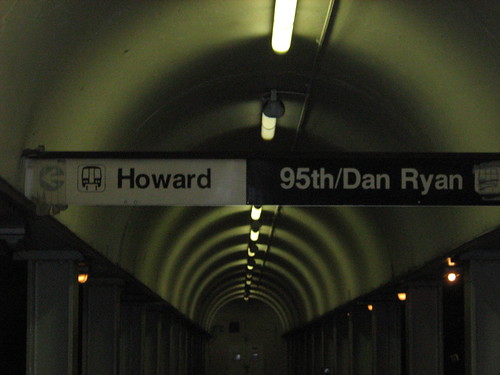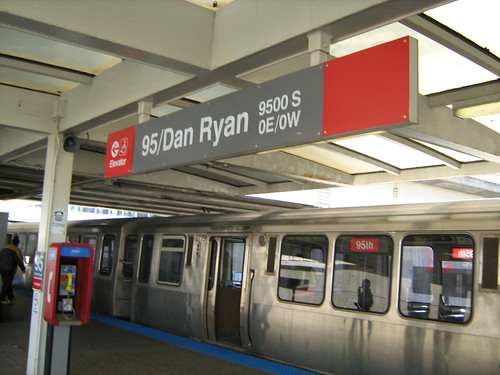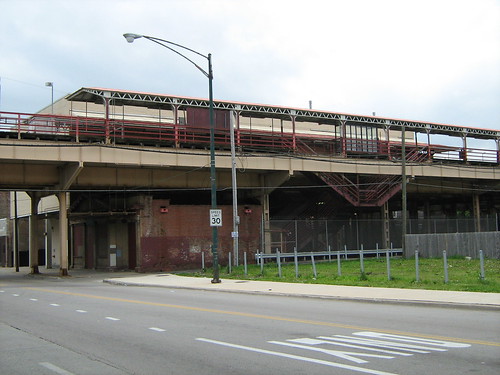Chicago is a world class city in many ways. It has many amenities like an extensive public transportation system. The Chicago Transit Authority (CTA) oversees the buses and trains which travel the city. However, the system has many inequalities and disparities that affect how different people can access the system. Over time many services have been cut, disproportionately affecting those in low income areas.
According to the CTA System Map, there is a greater amount of public transportation in the Central area and on the North side of the city than there are on the South or West sides. Even though there is a greater need for public transportation in these areas, the south and west sides of the city are still greatly under served.
CTA System Map
Inequality in CTA construction projects and upgrades is common in terms of funding and how such projects are carried out. For example, the Green Line, which serves primarily working class to low income African American neighborhoods on the south and west sides, was completely closed for about two years during the 1990's, leaving residents with few other choices for public transportation. This impacted residents' abilities to hold jobs, seek medical care, have a safe means of travel, and to make use of resources outside of their cut off areas.
Green Line History The CTA Reinvents Itself: The "L" Heads Into the 21st Century (1990-present)
In contrast, the Brown Line, which serves primarily middle to upper class white neighborhoods on the North side, had only a few nonconsecutive stations closed at one time, each for about one year, during the five year project span which was recently completed.
Thus, residents in these neighborhood experienced less disruption or hardship as a result of the construction project. These examples illustrate that inequalities in public transportation exist and how they disproportionately impact the ability of people from different backgrounds to make use of city resources.
CTA Brown Line Project Website 6/10/08 via Internet Archive
In terms of geographic coverage, the CTA system is very unequal. There are many examples of inequality in terms of where bus and or train routes run. The CTA Red Line reaches the city northern limits at Howard Street and continues north via the Purple Line to Linden Avenue in Wilmette. However, the Red Line does not reach the southern city limits at 138th Street. Service south of 95th Street is provided via various bus routes.
CTA System Map
There is proposal to extend the the Red Line further south toward to 130th Street from it's current terminal at 95th Street and the Dan Ryan Expressway, in order to provide better services to this traditionally under served area. This proposal is intended to better serve those in working class and lower class neighborhoods.
Red Line Extension.
In contrast to enhancement of services, reductions in public transit service have been more common than improvements in recent years and have taken the form of reductions in frequency of service, elimination of certain bus lines and transit stops, and elimination of overnight Night Owl service on some routes.
1997 CTA Service Cuts Internet Archive
These service cuts often happen in outlying areas of the city populated by lower income residents where deficiencies in public transit services already exist. These reductions have left people waiting longer for a bus or train or forced them to walk greater distances to access transit, often in high crime areas. Examples of these reductions are provided below.
The CTA Green Line has experienced the greatest reduction in the number of stations of any line in CTA history. Several South Side stations have been eliminated over time, leaving huge gaps in transit access for residents in these areas. For example, on the East 63rd (Jackson Park) branch of the Green Line, the track previously extended one mile further east than it does today, resulting in the elimination of three transit stations East 63rd Branch.
Similarly, three stations along the Englewood (Ashland) Branch were also eliminated over a 20 year period, leaving a huge gap approximately two miles long.
Englewood Branch
Residents of the Garfield Park area on the West Side were particularly upset when the Homan Avenue Green Line station in their neighborhood, which was served by a bus was relocated to Central Park Avenue, resulting in great inconvenience, because the purpose of the relocation was to provide better service for tourists to the nearby Garfield Park Conservatory. This example shows that tensions between funding the transit needs of tourists and businesspeople versus those of everyday residents also exist within specific neighborhoods that have tourist attractions. Once again, inequality exists and favors the few over the many. W. Siders protest plan to rebuild CTA station- Chicago Sun Times 6/3/1998
Reductions on the Blue Line's Congress Branch provide further examples of inequality within the CTA transit system. Three stations that were closed on the West side in 1973 due to budget cuts and have not been reopened. These closures created gaps of up to one and one half miles between stations. It was particularly unfortunate that the stop closed at Central Avenue is only one block away from Loretto Hospital, one of the few hospitals on the West side. This closure further reduced direct access to medical care and a source of employment on the already impoverished West side. In addition to inequalities in transit across the city, there also exist inequalities in residential development in different neighborhoods of the city, in part because of gentrification. Congress Branch



No comments:
Post a Comment